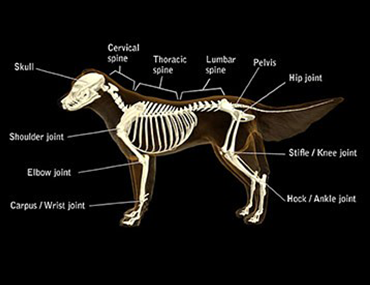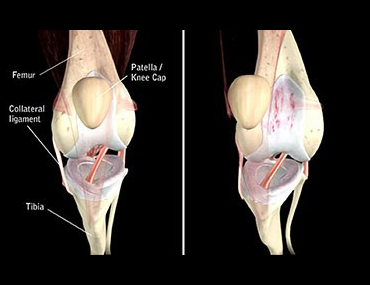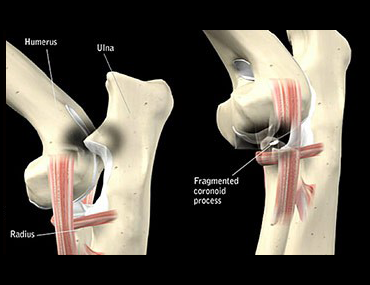Overview
Is your dog limping? Dogs of all ages can limp for a variety of reasons. In this article, we will focus on some bone diseases that affect growing dogs, causing them to limp! The cause may be minor and resolve on its own, but others can be more serious and lead to permanent lameness or debilitating conditions such as arthritis. Therefore, it is important to work with your veterinarian to determine why your dog is limping.
If your furry friend is a large-breed dog, those weighing more than 60 pounds when fully grown, there areseveral bone-related diseases that can occur during your dog’s “growth spurt,” which is ongoing until the age of 2.

If your pet has a persistent limp and your veterinarian suspects a bone disease, he or she will likely recommend x-rays to investigate why your dog is lame. Several x-rays of each affected leg are necessary to examine the various bones and joints that may be impacted. Often this procedure will require a short-acting anesthetic or sedative in order to achieve the optimal positioning for the x-rays. Your veterinarian may recommend preanesthetic blood tests to ensure your dog has the safest anesthetic experience possible. Additionally, your veterinarian may recommend that the x-rays are be reviewed by a veterinary radiologist for the most accurate diagnosis possible.
What are common bone disorders in a young dog?
The following diseases are common causes of lameness in growing dogs:
Osteochondritis dissecans (OCD) is condition caused by a flaw on the smooth cartilage surface within one or more joints. In a dog with OCD , the cartilage on the end of a bone in the joint develops abnormally and separates from the underlying bone. The shoulder joint is most commonly affected, but the elbow, hip, or knee (stifle) may also be involved. Sometimes there is a flaw in a flap of cartilage or a crack in the cartilage located on the end of the bone. If the dog’s activity is severely restricted for several weeks, he often may heal without intervention. If a piece of cartilage breaks off and is floating loose in the joint, your veterinarian may recommend surgery to remove the “floating" piece of cartilage. This condition often causes your pooch some pain, which varies from mild, intermittent limping to intense, constant pain; therefore, medications to relieve pain and reduce inflammation may be prescribed.
Panosteitis is commonly referred to as “growing pains” and is caused by an inflammation on the surface of the long bones. This can impact more than one bone at a time, causing your dog to have a "shifting" lameness that goes from one bone or leg to another. Because this is caused by rapid growth, it is self-limiting and treatment usually involves medication to alleviate the pain.
Hypertrophic osteodystrophy (HOD) is caused by an inflammation in the growth plates of your dog’s long bones. Swelling, pain in the joints, fever, and loss of appetite are the most common symptoms. Because it is caused by rapid growth, it is a self-limiting condition and often has no permanent side effects. In rare cases, permanent damage may occur to the growth plates, resulting in deformed legs. Treatment of this condition usually involves medication to relieve pain and reduce inflammation.

Ununited Anconeal Process (UAP) is caused by a developmental defect of a small piece of bone that is found on the back of the longer of the two bones of the forearm (the ulna) located at the rear of the elbow. As the dog reaches puberty, the growth plate that is found between this spot and the rest of the ulna closes and the parts of the bone fuse together. When a dog has UAP, the elbow joint becomes unstable because this part of the ulna does not fuse. This condition can be very painful, especially when the elbow is extended. Dogs with UAP are often lame and the condition can quickly develop into degenerative joint disease or arthritis. Surgery is required to treat UAP and is most successful when completed before secondary arthritis affects the joint. Elbow dysplasia is caused by an abnormal growth or development in the elbow joint and can create problems in the three different bones of the elbow joint—the radius, the ulna, and the humerus. The three different conditions are referred to as an ununited anconeal process (UAP), a fragmented coronoid process (FCP), or osteochondritis dissecans (OCD).

- FCP is a developmental defect within the elbow joint of one of the two small bony protrusions on the end of the long forearm bone (ulna). In this condition, a fissure or crack develops and the protrusion separates from the rest of the bone, causing pain and an unstable joint. Surgery is required immediately to prevent arthritis from developing in the joint. This is a hereditary condition affecting large-breed dogs, especially retrievers, rottweilers, and German shepherds. The recommended treatment is surgery.
- OCD has already been discussed earlier in the article.
Hip Dysplasia occurs when the hip joint, a “ball and socket” joint, forms improperly. As a dog grows, both the ball and socket need to grow at similar rates. Hip dysplasia, or an abnormal growth development of the hip, happens with the ball and socket don’t grow at an equal rate, resulting in the two not fitting together properly. This causes the hip(s) to become loose or "out of place," causing lameness, pain, and secondary arthritis.
Hip dysplasia is considered to be a hereditary disease and is commonly found in large-breed dogs such as golden retrievers, Labrador retrievers, mastiffs, German shepherds and rottweilers, to name a few. Because hip dysplasia is a hereditary disorder, dogs with hip dysplasia should not be used for breeding. Various radiographic procedures are used to diagnose and grade hip dysplasia.
When a dog is plagued with severe hip dysplasia, he or she may have trouble going from a lying to standing position and may walk with a limp. Dogs with mild hip dysplasia may show no signs of lameness. In both situations, secondary arthritis generally develops as the dog ages, causing pain and reduced mobility. There are several options for treating hip dysplasia, including various types of surgery and medication. Talk with your veterinarian to determine which treatment is best for your dog.
Since these disorders affect primarily large breed dogs during their growing years, maintaining an appropriate plane of nutrition during that time may help decrease the chances of your pet developing some of these disorders. Talk to your veterinarian about the best diet for your dog as he grows and matures into adulthood. A proper diet may help your dog maintain healthy joints and hips!
If you have any questions or concerns, you should always visit or call your veterinarian – they are your best resource to ensure the health and well-being of your pets.
